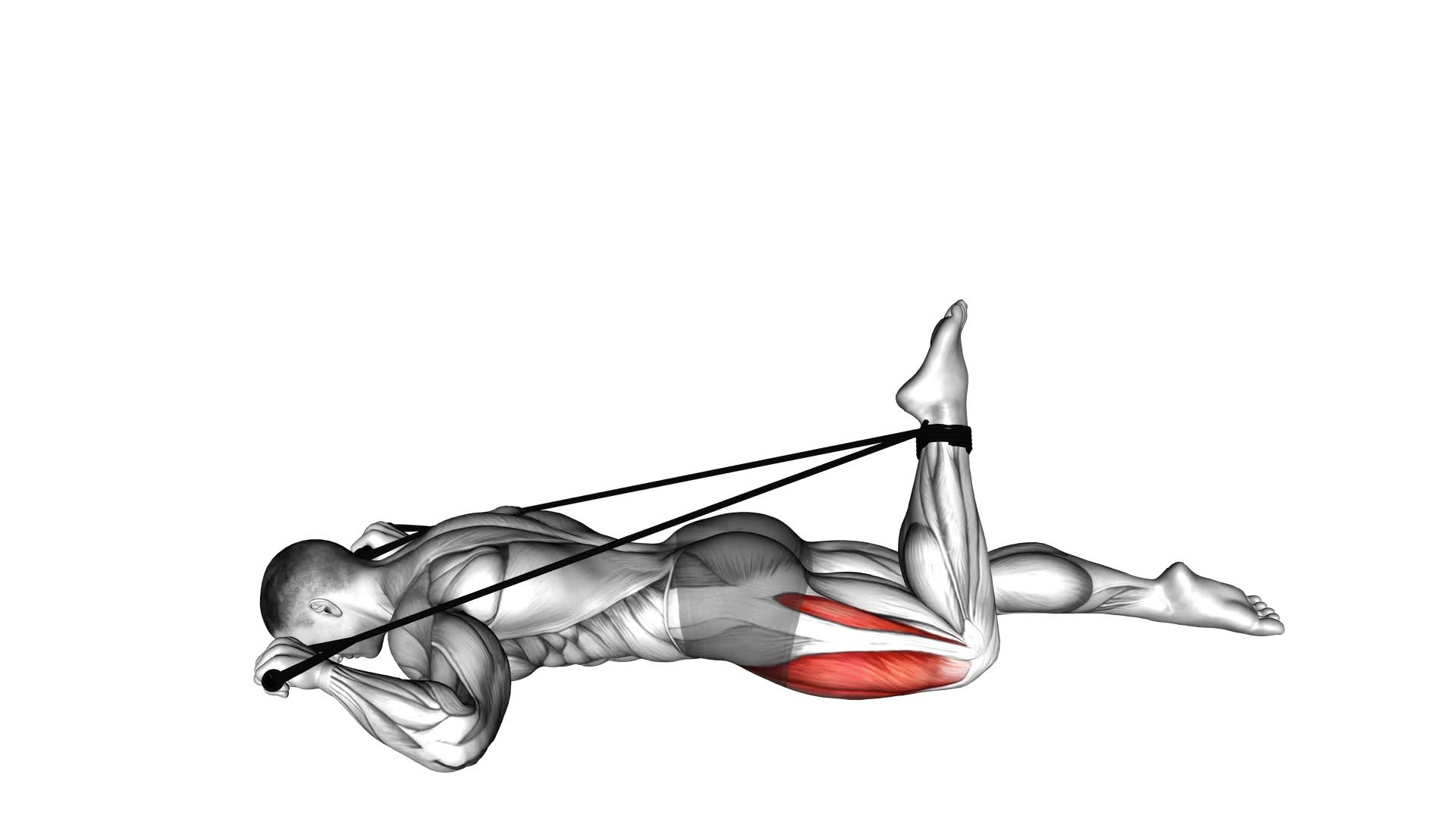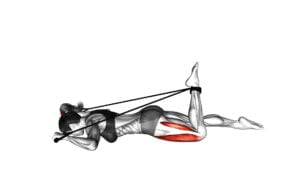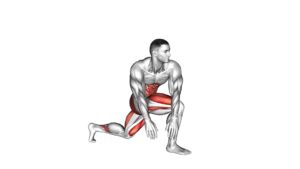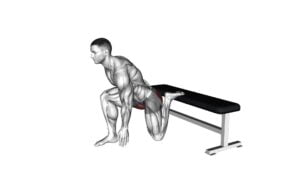Intermediate Hip Flexor and Quad Stretch – Video Exercise Guide & Tips

Are you looking to improve your hip flexibility and strengthen your quads? Look no further than the Intermediate Hip Flexor and Quad Stretch.
Watch This Exercise Video
This video exercise guide and tips will show you the proper form and alignment for the stretch, along with modifications to increase or decrease intensity. Avoid common mistakes and learn how to incorporate this stretch into your workout routine.
Start feeling the benefits today with this effective and efficient exercise.
Key Takeaways
- The Intermediate Hip Flexor and Quad Stretch improves flexibility and reduces muscle tightness.
- Proper form and alignment during the stretch are important to prevent common mistakes and maintain proper alignment.
- Modifications and variations can be used to increase or decrease the intensity of the stretch.
- It is recommended to incorporate the stretch into your workout routine by warming up muscles before and performing the stretch after your workout.
Benefits of the Intermediate Hip Flexor and Quad Stretch
To understand the benefits of the Intermediate Hip Flexor and Quad Stretch, you need to know that it can help improve flexibility and reduce muscle tightness. This stretch targets the hip flexor muscles, which are responsible for bringing your knee toward your chest and help in maintaining an upright posture. By regularly performing this stretch, you can increase the range of motion in your hips and improve flexibility.
Improving flexibility is crucial for maintaining proper muscle function and preventing muscle imbalances. When certain muscles become tight and others become weak, it can lead to poor posture, decreased range of motion, and an increased risk of injury. The Intermediate Hip Flexor and Quad Stretch can help prevent these imbalances by lengthening and stretching the hip flexor muscles.
Another benefit of this stretch is that it can reduce muscle tightness. Tight hip flexors can restrict movement and cause discomfort, especially in activities that require hip extension, such as running or squatting. By regularly incorporating the Intermediate Hip Flexor and Quad Stretch into your routine, you can alleviate tightness and improve your overall mobility.
Proper Form and Alignment for the Stretch
To perform the Intermediate Hip Flexor and Quad Stretch with proper form and alignment, follow these steps.
- Start by standing upright with your feet hip-width apart.
- Take a step forward with your right foot, keeping your knee directly above your ankle.
- Engage your core muscles to maintain stability throughout the stretch.
- Next, slowly lower your left knee to the ground, placing a mat or towel underneath for cushioning if needed.
- Keep your torso upright and avoid leaning forward or backward.
- Gently shift your weight forward onto your right leg until you feel a stretch in the front of your left hip and thigh.
- Hold this position for 20-30 seconds, breathing deeply and focusing on relaxing the targeted muscles.
Common mistakes to avoid during this stretch include:
- Allowing your front knee to extend past your toes.
- Rounding your lower back.
- Leaning too far forward.
These errors can compromise proper alignment and increase the risk of injury. Remember to maintain a neutral spine and engage your core muscles to support your posture.
Now that you understand the proper form and alignment for the Intermediate Hip Flexor and Quad Stretch, let's move on to modifications and variations to increase or decrease intensity.
Modifications and Variations to Increase or Decrease Intensity
To increase or decrease the intensity of the Intermediate Hip Flexor and Quad Stretch, you can make modifications and variations.
There are several ways to modify the stretch to suit your needs. One option is to use a yoga block or a folded towel under your knee for added support and to decrease the intensity of the stretch. This can be helpful if you're a beginner or if you have limited flexibility.
On the other hand, if you want to increase the intensity of the stretch, you can try lifting your back foot off the ground and reaching your arm overhead. This will engage your core and challenge your balance as well.
Another variation to increase the intensity is to perform the stretch on an unstable surface, such as a balance board or a foam pad. This will require more strength and stability, intensifying the stretch.
Remember to listen to your body and choose the modifications or variations that feel comfortable and effective for you.
Common Mistakes to Avoid During the Stretch
Avoiding common mistakes is important when performing the Intermediate Hip Flexor and Quad Stretch. To ensure you're getting the most out of this stretch and avoiding any potential injuries, make sure to pay attention to proper alignment. Here are some common mistakes to avoid:
- Arching your lower back: Keep your core engaged and your spine in a neutral position. Avoid arching your lower back as this can put unnecessary strain on your spine.
- Rounding your shoulders: It's important to maintain proper posture during the stretch. Avoid rounding your shoulders forward and instead, focus on keeping your chest lifted and your shoulders relaxed.
- Overstretching: While it's important to feel a stretch, be careful not to push yourself too far. Overstretching can lead to injury. Find a comfortable range of motion and gradually increase it over time.
By avoiding these common mistakes, you can ensure that you're performing the Intermediate Hip Flexor and Quad Stretch correctly and safely.
Now, let's move on to some tips for incorporating this stretch into your workout routine.
Tips for Incorporating the Stretch Into Your Workout Routine
Now let's delve into how you can effectively incorporate the Intermediate Hip Flexor and Quad Stretch into your workout routine. Incorporating this stretch into your routine can help improve flexibility and prevent muscle imbalances. Here are some tips to help you seamlessly integrate the stretch into your workouts.
First, make sure to warm up your muscles before doing the stretch. This can be done with some light cardio exercises or dynamic stretches. A warm-up will prepare your muscles for the stretch and reduce the risk of injury.
Next, choose the right time to do the stretch. It's best to perform it after your workout when your muscles are warm and more pliable. This will allow for a deeper and more effective stretch.
When incorporating the stretch, start with a lighter intensity and gradually increase the duration and intensity over time. This will help your muscles adapt and prevent excessive soreness or strain.
Additionally, consider adding variation to the stretch. You can modify the exercise by using props such as a stability ball or foam roller to enhance the stretch. This will keep your routine interesting and target different areas of your hip flexors and quads.
Finally, listen to your body. If you experience any pain or discomfort during the stretch, stop immediately and consult with a healthcare professional.
Frequently Asked Questions
How Long Should I Hold the Stretch for Maximum Benefit?
To get the maximum benefit from the stretch, it's important to hold it for the right amount of time.
The optimal stretching technique for your hip flexors and quads is to hold the stretch for about 20 to 30 seconds.
This duration allows the muscles to relax and lengthen, improving flexibility and reducing tightness.
Remember to breathe deeply and maintain proper form throughout the stretch to get the most out of it.
Can I Perform This Stretch if I Have a Previous Hip Injury?
If you have a previous hip injury, it's important to take certain precautions when performing the intermediate hip flexor and quad stretch. Make sure to listen to your body and stop if you feel any pain or discomfort.
You may need to modify the stretch to accommodate your injury, such as using props or adjusting the intensity.
It's always a good idea to consult with a healthcare professional or physical therapist for guidance specific to your condition.
Should I Warm up Before Attempting This Stretch?
Before attempting this stretch, it's important for you to warm up properly. Warming up helps increase blood flow to your muscles and prepares them for stretching.
If you have a previous hip injury, it's recommended to consult with a medical professional before attempting this stretch. They may suggest alternative stretches or modifications that are more suitable for your condition.
Always prioritize safety and listen to your body during any exercise routine.
Can I Do This Stretch if I Have Tight Hamstrings?
If you have tight hamstrings, you can still do this stretch. It's important to listen to your body and make modifications as needed. Focus on gently stretching your hip flexors and quads without straining your hamstrings too much. Keep your movements controlled and take it slow.
If you feel any discomfort or pain, stop and adjust the stretch to a level that's comfortable for you. Remember to prioritize hamstring flexibility and modify the stretch as necessary.
Can I Perform This Stretch if I Have Lower Back Pain?
If you have lower back pain, you may need to modify this stretch or try alternative hip stretches. Lower back pain can be aggravated by certain movements, so it's important to listen to your body and avoid any exercises that increase discomfort.
Consult with a healthcare professional or a certified trainer who can provide personalized advice and suggest appropriate modifications for your specific needs.
Always prioritize your safety and well-being during any exercise routine.
Conclusion
Incorporating the intermediate hip flexor and quad stretch into your workout routine can provide numerous benefits, such as improving flexibility and reducing muscle tightness.
Proper form and alignment are crucial to effectively target these muscles. Remember to avoid common mistakes and make modifications as needed to increase or decrease the intensity of the stretch.
By following these tips, you can optimize the effectiveness of this stretch and enhance your overall fitness journey.

Author
Years ago, the spark of my life’s passion ignited in my mind the moment I stepped into the local gym for the first time. The inaugural bead of perspiration, the initial endeavor, the very first surge of endorphins, and a sense of pride that washed over me post-workout marked the beginning of my deep-seated interest in strength sports, fitness, and sports nutrition. This very curiosity blossomed rapidly into a profound fascination, propelling me to earn a Master’s degree in Physical Education from the Academy of Physical Education in Krakow, followed by a Sports Manager diploma from the Jagiellonian University. My journey of growth led me to gain more specialized qualifications, such as being a certified personal trainer with a focus on sports dietetics, a lifeguard, and an instructor for wellness and corrective gymnastics. Theoretical knowledge paired seamlessly with practical experience, reinforcing my belief that the transformation of individuals under my guidance was also a reflection of my personal growth. This belief holds true even today. Each day, I strive to push the boundaries and explore new realms. These realms gently elevate me to greater heights. The unique combination of passion for my field and the continuous quest for growth fuels my drive to break new ground.







